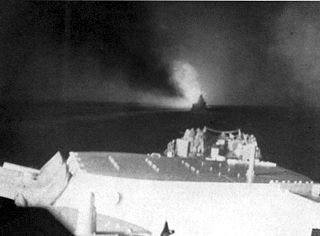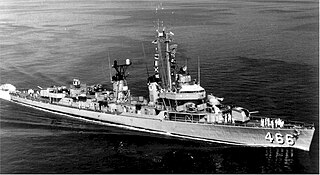
USS Claxton (DD-571), a Fletcher-class destroyer, was the second ship of the United States Navy to be named for Thomas Claxton, born in Baltimore, Maryland.

The Battle of Empress Augusta Bay, on 1–2 November 1943 – also known as the Battle of Gazelle Bay, Operation Cherry Blossom, and in Japanese sources as the Sea Battle off Bougainville Island (ブーゲンビル島沖海戦) – was a naval battle fought near the island of Bougainville in Empress Augusta Bay. The naval battle was a result of Allied landings on nearby Bougainville in the first action in the Bougainville campaign of World War II and may also be considered as part of the Solomons and New Guinea campaigns. The battle was significant as part of a broader Allied strategy—known as Operation Cartwheel—aimed at isolating and surrounding the major Japanese base at Rabaul. The intention was to establish a beachhead on Bougainville, within which an airfield would be built.

USS Honolulu (CL-48) of the United States Navy was a Brooklyn-class light cruiser active in the Pacific War. Honolulu was launched in 1937 and commissioned in 1938. The ship served in the Battle of Tassafaronga, the Battle of Kula Gulf, the Battle of Kolombangara and the Battle of Peleliu. She was taken out of action by serious torpedo damage just before the Battle of Leyte Gulf. She was repaired, but not in time to rejoin the war. She was decommissioned in 1947 and was held in reserve until she was scrapped in 1959.

USS Cleveland (CL-55) was the lead ship and one of the 27 United States Navy Cleveland-class light cruisers completed during or shortly after World War II. She was the second ship to be named for the city of Cleveland, Ohio.

USS Columbia (CL-56) was one of 27 United States Navy Cleveland-class light cruisers completed during or shortly after World War II. The ship, the sixth US Navy ship to bear the name, was named for the city of Columbia, South Carolina. Columbia was commissioned in July 1942, and saw service in several campaigns in the Pacific. Like almost all her sister ships, she was decommissioned shortly after the end of the war, and never saw active service again. Columbia was scrapped in the early 1960s. A memorial to the ship and men who served on her exists in Columbia, SC.

USS Denver (CL-58) was a Cleveland-class light cruiser. Denver launched on 4 April 1942 by New York Shipbuilding Corp., Camden, New Jersey; sponsored by Miss L. J. Stapleton, daughter of the Mayor of Denver; and commissioned on 15 October 1942, Captain Robert Carney in command. It was the second ship named for the city of Denver, Colorado.

USS Nashville (CL-43) was a Brooklyn-class cruiser. She was laid down on 24 January 1935 by New York Shipbuilding Corporation, Camden, New Jersey. She was launched on 2 October 1937, sponsored by Misses Ann and Mildred Stahlman and commissioned on 6 June 1938.

USS Charles Ausburne (DD-570), a Fletcher-class destroyer, was the second ship of the United States Navy to be named for Charles L. Ausburne, a sailor in World War I who was posthumously awarded the Navy Cross.

USS Eaton (DD-510) was a Fletcher-class destroyer in the service of the United States Navy from 1942 to 1946. She was recommissioned from 1951 to 1969 and sunk as a target in 1970.

USS Waller (DD/DDE-466), a Fletcher-class destroyer, was a ship of the United States Navy named for Major General Littleton Waller, USMC (1856–1926).

USS Fullam (DD-474) was a Fletcher-class destroyer in the United States Navy during World War II. Fullam was named for Rear Admiral William Fullam (1855-1926).

USS Stanly (DD-478) was a Fletcher-class destroyer in service with the United States Navy from 1942 to 1947. She was scrapped in 1972.

USS Converse (DD-509), a Fletcher-class destroyer, was the second ship of the United States Navy to be named for George A. Converse (1844–1909).

USS Foote (DD-511), a Fletcher-class destroyer, was the third ship of the United States Navy to be named for Rear Admiral Andrew Hull Foote (1806–1863), who served during the Civil War.

USS Thatcher (DD-514), a Fletcher-class destroyer, was the second ship of the United States Navy to be named for Rear Admiral Henry K. Thatcher (1806–1880).
The Shortland Islands archipelago is part of the Western Province of the Solomon Islands, at 6.92°S 155.88°E. The island group lies in the extreme northwest of the country's territory, close to the southeast edge of Bougainville Island, Papua New Guinea.

USS Dyson (DD-572) was a Fletcher-class destroyer of the United States Navy. She was named for Rear Admiral Charles W. Dyson (1861–1930).

USS Farenholt (DD-491) was a Benson-class destroyer in the United States Navy during World War II. She was the second ship named for Admiral Oscar Farenholt.

Sendai was a Sendai-class light cruiser in the Imperial Japanese Navy. She was named after the Sendai River in southern Kyūshū. Sendai was the lead ship of the three vessels completed in her class of light cruisers, and like other vessels of her class, she was intended for use as the flagship of a destroyer flotilla.

Shortland Island is the largest island of the Shortland Islands archipelago, in the Western Province of the Solomon Islands, at 7°3′S155°45′E.































